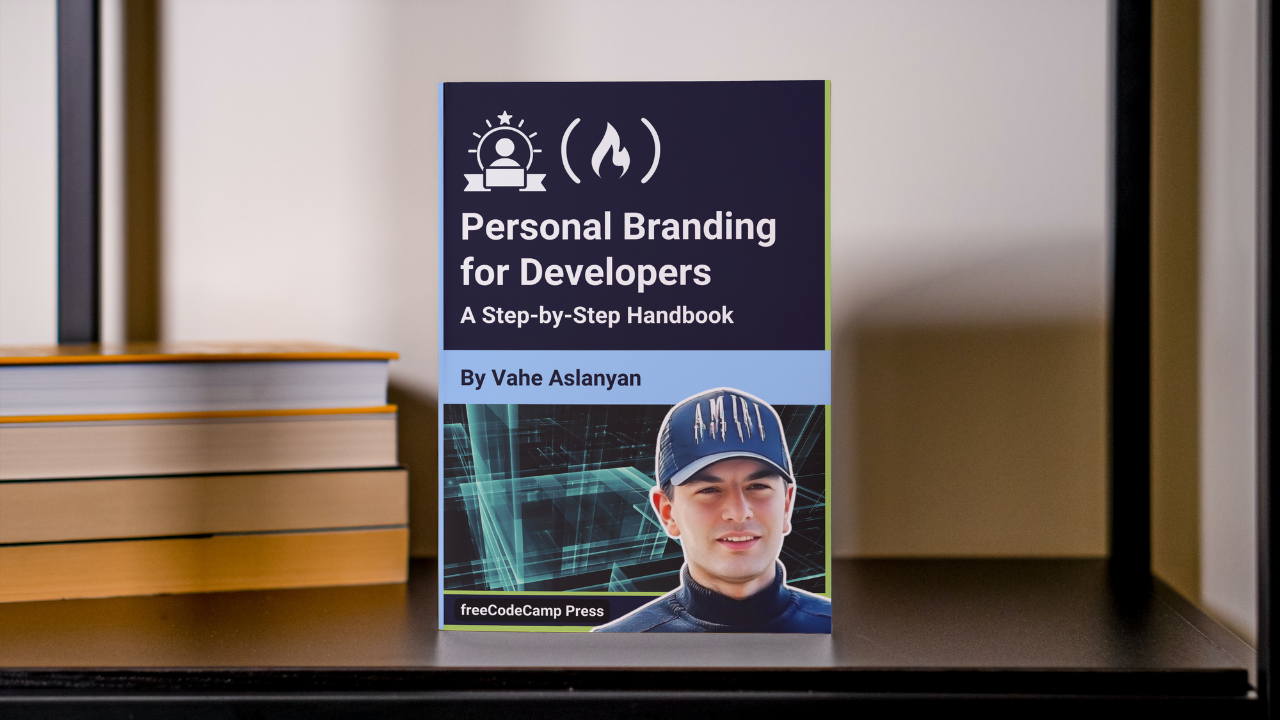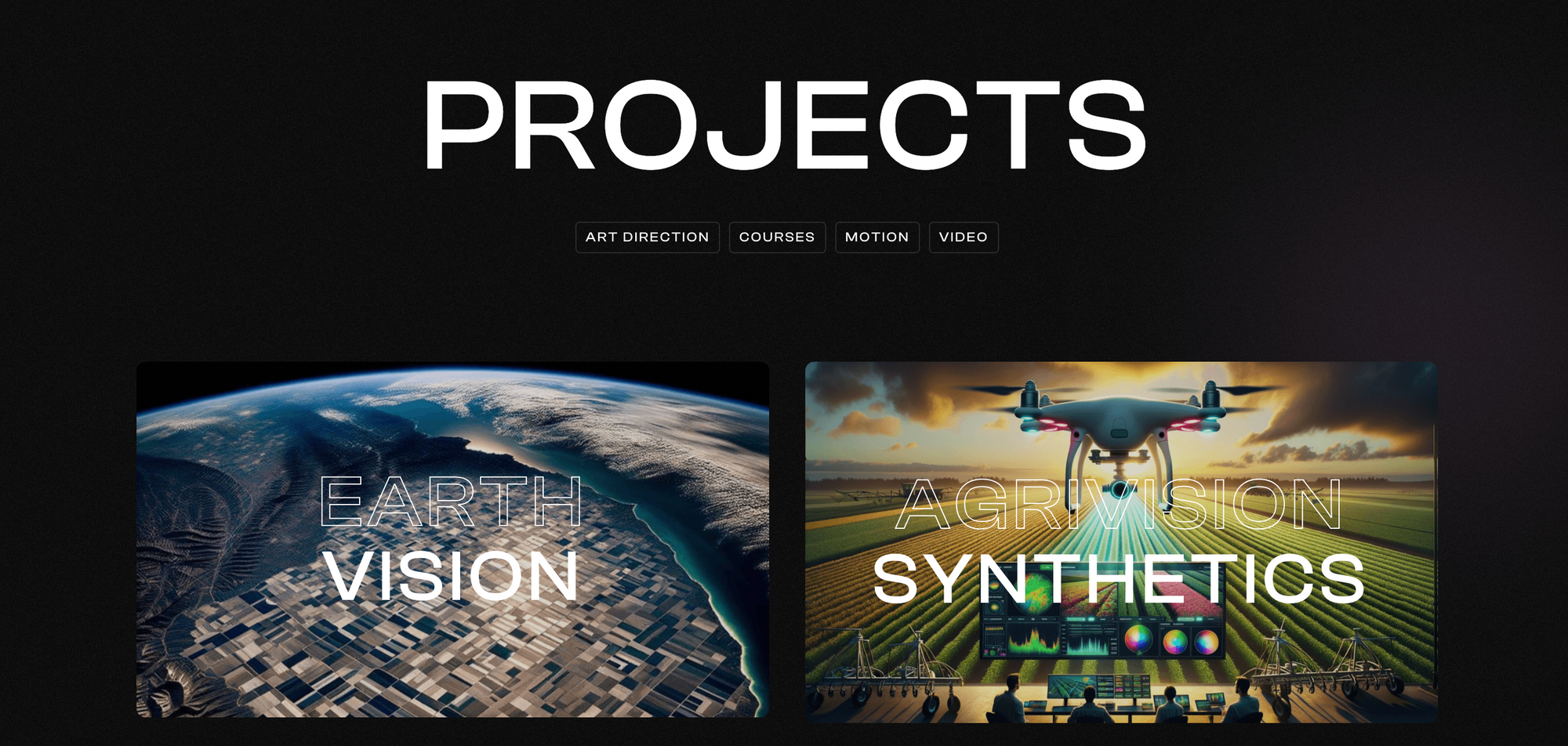Personal Branding for Developers – A Step by Step Handbook

[ad_1]
In this handbook, you’ll learn how to build your personal brand as a developer to help you make your mark in the tech industry.
With a focus on practicality and professionalism, this guide is designed for developers at all levels, from industry veterans to those just starting their coding journey.
I’ll share straightforward, effective strategies to help you enhance your visibility, demonstrate your expertise, and attract the right attention in the tech sector. You’ll discover how personal branding can systematically open doors to new job opportunities, streamline your networking efforts, and position you as a thought leader in your field.
We delve into the essential elements of personal branding tailored for developers. You’ll learn how to define and communicate your unique value proposition, create an engaging online persona, and tell a brand story that resonates with your audience. We’ll also guide you through using various platforms to broaden your reach and impact.
Personal branding is more than just a tool for success – it’s a critical component in today’s digital landscape for anyone looking to advance their career, grow their network, or expand their business.
Join me, and we’ll explore the transformative power of personal branding so you can forge a robust, respected identity that keeps pace with the ever-changing tech world.
Table Of Contents
- What is Personal Branding?
- Why is Personal Branding Important?
- How to Identify and Understand Your Audience
- How to Develop Your Unique Selling Proposition
- How to Build Your Brand
- How to Build Your Developer Portfolio
- How to Develop a Social Media Strategy to Amplify Your Online Presence
- How to Create Technical Tutorials That Resonate with the Community
- How to Engage with the Developer Community
- How to Attend and Speak at Developer Conferences
- How to Create and Share Impactful Developer Resources
- How to Network with Recruiters and Employees to Build Relationships
- How to Learn Continuously to Stay Relevant
- How to Manage Your Personal Brand as a Developer
- How to Continue to Evolve and Cultivate Your Brand
- Mastering Personal Branding for Developers: The Final Spark
Short Summary
- Personal branding is essential for developers to stand out from the crowd and attract opportunities.
- Understanding your target audience and identifying your unique selling proposition are key aspects of developer branding.
- Building an engaging developer portfolio, leveraging social media, and participating in developer communities can enhance your online presence.
- Continuous learning, monitoring your brand reputation, and evaluating your branding strategy are crucial for long-term success in personal branding as a developer.

1. What is Personal Branding?
At its essence, personal branding is the art of shaping the public’s perception of you. It’s how the world sees you, understands your competencies, and recognizes your contributions to the tech landscape.
Whether you’re perceived as a leader, innovator, or a burgeoning talent, these perceptions form the bedrock of your personal brand. It’s not just about identity – it’s about your identity as seen through the world’s lens, highlighting your unique skills, thoughts, and values.
Understanding the gravity of personal branding is crucial. Without a deliberate effort to craft and manage your personal brand, you might leave more than just opportunities on the table. You risk obscurity in a field that values visibility and distinctiveness.
Exceptional talent alone doesn’t guarantee recognition. It’s also how you’re perceived, from peers to potential employers, that defines your professional trajectory.
Personal branding for developers is more than curating a professional image through a résumé or social media. It’s an all-encompassing strategy that touches every aspect of your professional life. From the content you share, the networks you build, to the expertise you display, and the contributions you make to your community—every action contributes to how you are perceived.
This process demands more than passive engagement. It requires a proactive stance: identifying your unique selling points, consistently showcasing your skills, and engaging with your industry on multiple levels. It’s about making strategic decisions that align with your professional goals while staying true to your values and personality.
So, how do you master this art? We’ll go through what strategies you should use when starting out and when you’re scaling, as well as what tools to use, step by step. Let’s get started.

2. Why is Personal Branding Important?
Personal branding in software development is becoming a necessity for career growth. A robust personal brand distinguishes you as a developer, carving out a unique space in a crowded field and bringing a host of professional benefits.
Here’s why personal branding is indispensable for developers:
Differentiation in a Saturated Market:
These days, there are so many developer throughout the blobal market – so standing out is crucial. Personal branding can help be your spotlight in the crowded tech space, highlighting your unique skills and personality. It’s about making a mark, ensuring you’re not just another face in the digital crowd but a valuable, distinct presence.
Credibility and Trust:
Your personal brand is a reflection of your professional identity, a testament to your credibility. It’s what people discuss when you’re not present and plays a pivotal role in how you’re perceived in the industry. A well-crafted personal brand fosters trust and establishes your reputation as a reliable, skilled professional.
Gateway to New Opportunities:
A strong personal brand acts as a beacon, attracting diverse and exciting career opportunities. It’s the key to unlocking doors to job offers, freelance projects, speaking engagements, and more. Essentially, it aligns your professional persona with your career aspirations, drawing opportunities that resonate with your goals.
Community Engagement and Networking:
Building your personal brand is an opportunity to engage with a community of peers and industry leaders. It’s about joining conversations, sharing insights, and staying abreast of trends. This engagement is invaluable for learning, idea exchange, and keeping your finger on the pulse of the tech world.
Ensuring Career Longevity:
In an industry that’s constantly evolving, personal branding is more than self-promotion – it’s about future-proofing your career. Keeping your brand aligned with industry advancements shows adaptability and forward-thinking, essential traits in the dynamic world of technology.
In summary, personal branding for developers is about more than just visibility. It’s also a strategic approach to shaping your career trajectory, building professional relationships, and staying relevant in an ever-changing industry.

3. How to Identify and Understand Your Audience
As you begin your journey in personal branding as a developer, your first vital task is to identify your target audience. This step is crucial in determining where you can establish yourself as an authority and maximize your value proposition.
Choosing between a saturated or niche market is a significant decision. As a developer, especially if you’re just starting, spreading yourself too thin across multiple domains can rapidly drain your resources. Focus is paramount.
To truly understand your target audience, you need to dive deep into research. Are you looking to connect with startups in need of web development expertise? Or are you aiming to engage with large corporations in search of advanced AI solutions? Perhaps your ideal audience is fellow developers who would benefit from your specialized knowledge in a particular programming language. Each of these groups demands a unique approach and set of expertise.
Consider these potential target audiences for developers:
- Startup Founders: These are individuals looking for cost-effective, innovative tech solutions for their burgeoning businesses.
- Enterprise Executives: They seek scalable and robust software solutions to enhance their company operations.
- Fellow Developers: Your peers in the industry who are interested in knowledge-sharing, mentorship, and collaboration in specific tech areas.
- Tech Enthusiasts: Individuals eager to keep up with the latest trends, tools, and technologies in the tech world.
- Non-Tech Businesses: Organizations needing assistance to integrate tech solutions into their traditional business models.
To identify and connect with these groups, examine aspects such as demographics, professional backgrounds, skill levels, goals, and challenges. By creating detailed personas of your ideal audience, you can better visualize their needs and craft your brand message to resonate with them effectively.
In essence, the success of your personal branding as a developer lies in your ability to clearly understand your target audience. It involves making strategic choices about where to direct your efforts, ensuring that your personal brand accurately reflects your expertise and appeals to the audience you seek to influence.

4. How to Develop Your Unique Selling Proposition
Now that you’ve grasped the importance of personal branding and chosen your market to establish authority, it’s time to define your Unique Selling Proposition (USP). Your USP distinguishes you, highlighting the unique attributes, skills, and experiences that make you an invaluable asset.
Let’s use the example of a data scientist to explore how you can identify your USP.
As a data scientist, your journey to expertise is a significant part of your USP. This expertise might include advanced analytical skills, proficiency in specific data science tools, or a deep understanding of machine learning algorithms. Your technical skills set the foundation of your USP.
Next, consider your professional achievements. These might include awards, notable projects, or prestigious work experiences, like roles at FAANG companies. Such achievements add weight to your USP, demonstrating your proven track record in the field.
Beyond technical prowess and achievements, your soft skills are equally crucial. As a data scientist, your ability to work effectively in team environments, communicate complex ideas clearly, and problem-solve creatively are invaluable traits. These soft skills can often be the differentiator in a field where technical expertise is a given.
Here’s how to crystallize your USP as a data scientist:
- Skill and Expertise Assessment: Reflect on your core competencies. Are you an expert in Python or R? Do you excel in predictive modeling or data visualization? List these skills.
- Define Your Niche: Specialize in a specific area of data science that aligns with your interests and skills. It could be anything from bioinformatics to financial data analysis.
- Highlight Achievements: Showcase your major accomplishments. This could be your role in a significant project, papers published, or awards won.
- Identify Your Unique Perspective: What is your approach to data science? Maybe you have a knack for translating data insights into effective business strategies or a unique method for data cleaning and preparation.
- Craft Your Personal Brand Statement: Combine your skills, niche, achievements, and unique perspective into a succinct personal brand statement. This should reflect who you are as a data scientist, what you bring to the table, and why you stand out in your field.
By identifying and articulating your USP, you position yourself as a data scientist of choice in your chosen niche. Remember, personal branding is dynamic. Continually refine your USP as you gain new experiences and skills.

5. How to Build Your Brand
Developing your brand identity as a developer is essential for shaping public perception and building a solid professional reputation. It’s more than just showcasing your technical prowess – it’s also about encapsulating your values, personality, and the unique traits that distinguish you in the tech arena.
Here are some steps to help you effectively define and refine your brand identity:
Conduct a Thorough Skills Analysis
For developers, a meticulous skills analysis is not just about listing the languages and tools you’ve used. It’s also a strategic evaluation aimed at defining your professional niche and competitive edge. This involves a granular breakdown of your competencies, project experiences, and the unique challenges you’ve overcome through your technical skills.
Here’s how you can approach this analysis with precision:
- Inventory Your Technical Toolkit: Start by creating a comprehensive list of the programming languages (for example, Java, Python, JavaScript), frameworks (for example, Angular, React, Node.js), and technologies (for example, AWS, Docker, Git) you are proficient in. This step forms the foundation of understanding your skill set.
- Rate Your Proficiency: For each item on your list, assign a proficiency level. Use categories like ‘beginner,’ ‘intermediate,’ and ‘expert’ or a scale from 1 to 10. Be honest with yourself about where your strengths truly lie. This assessment will help you identify areas where you excel and those that may require further development.
- Reflect on Project Experiences: Think about the projects you’ve worked on, especially those where your contribution was pivotal to success. What challenges did you face, and how did you overcome them? Did you implement a novel solution to a technical problem? This reflection will highlight your problem-solving skills and areas of expertise.
- Identify Unique Problem-Solving Abilities: Beyond technical skills, consider the unique ways you approach problem-solving. Maybe you have a knack for optimizing performance in complex systems or a creative approach to debugging. These are your unique selling points that set you apart.
- Document Learning and Growth: Acknowledge the courses, certifications, or self-taught skills you’ve acquired outside of formal education. Continuous learning is a significant asset in the tech industry, showcasing your dedication to staying current.
- Seek Feedback: Sometimes, others can offer insights into your strengths that you might overlook. Ask colleagues, mentors, or peers for their perspective on your technical abilities and areas of impact.
Clearly Identify Your Target Audience
Understanding your audience is pivotal in aligning your personal brand with market needs. Here’s how to precisely identify and connect with your target groups:
- Segment Your Audience: Categorize potential audiences into groups such as startups, mid-sized companies, large enterprises, fellow developers, or non-technical stakeholders. Each group has different needs and challenges.
- Analyze Needs and Challenges: For each segment, delve into the specific problems they face and how your skills can offer solutions. Startups might need rapid prototyping skills, whereas large enterprises may value your ability to scale systems efficiently.
- Tailor Your Message: Customize how you present your skills and experiences to resonate with the specific audience segment. Highlight your startup experience when engaging with new ventures or emphasize your enterprise-level project management skills for larger organizations.
- Engage Appropriately: Choose platforms and communication styles that align with your target audience. LinkedIn might be more suitable for professional networking, while GitHub and Stack Overflow can showcase your technical expertise to fellow developers.
Formulate a Strong Value Proposition:
A value proposition is a clear statement that explains how your skills and expertise solve the challenges faced by your target audience, the specific benefits you deliver, and why you’re the best choice among the alternatives.
For developers, creating a compelling value proposition involves deep understanding of your audience’s needs, aligning your skills to meet those needs, and communicating your unique advantages effectively.
Here’s how you can formulate your own value proposition:
- Identify Audience Challenges: Start by identifying the common challenges or pain points faced by your target audience. For instance, startups might struggle with building scalable products quickly, while large enterprises may face challenges in legacy system integration.
- Align Your Skills with Audience Needs: Map your technical skills and experiences to these challenges. If you’re adept at developing scalable applications using modern frameworks and languages, this skill directly addresses the startup’s challenge. Similarly, your experience in integrating new technologies with existing legacy systems would be invaluable to large enterprises.
- Highlight Unique Benefits: Consider what sets you apart from others with similar skills. Perhaps it’s your track record of delivering projects on time, your ability to work seamlessly with cross-functional teams, or your innovative problem-solving approach. These unique benefits make your value proposition stronger.
- Craft a Clear and Concise Statement: Combine the above elements into a clear, concise statement. For example, “I leverage my expertise in [specific technologies] to help startups accelerate product development, ensuring scalability and performance from the outset. My approach combines rapid prototyping with a focus on long-term technical strategy, providing startups with the foundation for growth.”
- Tailor Your Value Proposition: Different segments of your audience might value different aspects of your work. Customize your value proposition based on who you’re addressing. The more relevant your message is to the listener, the more impactful it will be.
Examples of strong value propositions for developers:
- For a Full-Stack Developer: “I specialize in building full-stack applications that are as scalable as they are intuitive to use. By integrating cutting-edge front-end technologies with robust back-end systems, I deliver seamless user experiences that drive engagement and growth.”
- For a Data Scientist: “Utilizing advanced data analytics and machine learning, I transform vast data sets into actionable insights, enabling businesses to make data-driven decisions that propel them ahead of the competition.”
- For a DevOps Engineer: “I streamline software development and deployment processes, significantly reducing time to market while ensuring high-quality releases. My expertise in continuous integration and continuous delivery (CI/CD) practices minimizes downtime and maximizes productivity.”
In essence, a strong value proposition for developers states what you do, as well as clarifies the tangible outcomes your work achieves for your clients or employers. It communicates your worth in a way that resonates with their specific needs and distinguishes you from the competition, making it clear why you’re the best person for the job
“Your brand is a reflection of your professional essence, resonating even in your absence.” – Jeff Bezos
Develop a Cohesive Brand Persona:
Shape the personality and voice of your brand. Decide on the image you want to project – be it as a reliable solution-finder, an innovative thinker, or a strategic visionary. Align this persona with your core values for authenticity and consistency.
Establish Yourself as a Thought Leader:
To establish yourself as a thought leader within the tech community, you must go beyond simply sharing your expertise. You must become a beacon of insight, innovation, and inspiration to your peers and audience.
A thought leader is someone who, through their content, actions, and expertise, shapes the conversations happening in their field.
Identify Your Niche:
Focus on a specific area within technology where you possess deep knowledge and passion. This could be anything from machine learning, cybersecurity, cloud computing, to web development practices.
A narrow focus allows you to dive deeper and offer more insightful commentary than if you spread yourself too thin.
Produce High-Quality Content:
Start by creating content that showcases your expertise and insights. This could be in the form of:
- Blog Posts: Write in-depth articles on current trends, future predictions, or tutorials that solve specific problems. Your blog could become a go-to resource for those looking to stay updated or learn new skills in your niche.
- Whitepapers and E-books: These provide an opportunity to explore topics more comprehensively and can establish your expertise on complex subjects.
- Videos and Webinars: Visual content like tutorials, discussions on tech news, and webinars can help you reach a wider audience who prefer learning through video.
Speak at Industry Events and Conferences:
Apply to speak at tech meetups, conferences, and seminars. These platforms offer a great way to share your knowledge, network with other professionals, and get your name out there. Tailor your talks to offer unique perspectives or solve common problems in innovative ways.
Leverage Social Media:
Use platforms like LinkedIn, Twitter, and even Instagram to share your content, engage with tech trends, and participate in discussions. Social media can amplify your reach and help you connect directly with your audience.
Collaborate with Peers:
Collaborate on projects, articles, or research papers with other professionals in your field. These collaborations can introduce you to new audiences and add credibility to your expertise.
Offer Mentorship:
Offering guidance to up-and-coming professionals not only contributes to the community but also cements your status as an expert who is confident enough in their knowledge to teach others.
Stay Informed and Current:
Continuously update your knowledge base. Tech fields evolve rapidly, and staying on top of new developments is crucial. Use this ongoing learning to inform your content and discussions, keeping your audience informed about the latest trends and technologies.
Examples of Thought Leadership Activities:
Writing a Series on Emerging Tech Trends: For example, a series of articles exploring the impact of AI on web development practices could attract a significant following if it offers unique insights and practical advice.
Hosting a Podcast: Invite other experts to discuss new technologies, ethical considerations in tech, or career advice for developers. This not only provides value but also associates your brand with other respected voices in the industry.
Creating a Coding Bootcamp: Offer an online course or bootcamp that tackles a niche area within your expertise. This positions you as a go-to expert for learning and development in that space.
Establishing yourself as a thought leader is a commitment to sharing knowledge, fostering community, and continuously learning. It’s about offering value that not only showcases your expertise but also propels the industry forward. By following these steps and consistently delivering quality, you can build a reputation as a trusted authority in your field.
The journey to define your brand identity as a developer involves:
- In-depth self-analysis of your skills and expertise.
- Precise identification of your target audience.
- Crafting a value proposition that highlights your unique contributions.
Implement these strategies to build a brand that not only showcases your technical skills but also resonates with your professional ethos and aspirations.

6. How to Build Your Developer Portfolio
Creating a compelling and impactful developer portfolio is an essential part of your personal branding strategy. It’s your digital showcase, presenting your skills, expertise, and project achievements to potential clients or employers.
Here’s a detailed, step-by-step plan to craft an engaging developer portfolio:
Design Your Personal Portfolio Website:
Creating a professional portfolio website is a pivotal step in showcasing your expertise and establishing your digital presence. Whether you’re a web developer, a machine learning engineer, or a data scientist, your portfolio is a visual representation of your professional journey and accomplishments.

Here’s how to create a portfolio that stands out:
1. Choose the Right Platform:
If you’re a web developer, leveraging your skills to custom-build your site can demonstrate your proficiency. But for professionals like machine learning engineers or data scientists, time-efficient options like Webflow, WordPress with Elementor, or other website builders offer a practical solution to craft a polished website without the need to code from scratch.
2. Essential Pages to Include:
While every portfolio is unique, certain pages are foundational to effectively communicating your professional narrative:
- About Page: This is where you tell your story, sharing your background, skills, and what drives you.
- Projects Page: Showcase your best work, projects, or research, detailing the challenges, your solutions, and the impact of your work.
- Contact Me Page: Make it easy for potential employers or collaborators to reach out to you with a simple and straightforward contact form or your professional contact details.
3. Designing the Home Page:
The home page sets the tone for your entire site. It should reflect your personal and professional identity. Think of it as the cover of your professional book – it should invite visitors to explore more about you.
Incorporate elements that represent your interests and professional ethos, such as your favorite colors, design style, and highlights of your work. For example, a website like vaheaslanyan.com immediately introduces Vahe Aslanyan (that’s me) through interests and professional focus, using a clean design that blends favorite colors with a clear narrative.
4. Clean, Modern Design:
When crafting the design of your portfolio website, aim for a style that reflects your unique personality while upholding a professional appearance. A minimalist design is often the most effective, characterized by its simplicity, use of white space, and focus on content rather than heavy design elements.
This approach helps highlight your projects and achievements without distractions.
For example, a web developer might feature a simple, elegant layout with interactive elements to demonstrate coding skills, whereas a graphic designer might incorporate bold visual elements that showcase creativity.
The key is to ensure the design aligns with the kind of work you do, making your site a direct reflection of your professional capabilities and aesthetic sensibility.
5. Domain Name:
Choosing the right domain name is critical for brand recognition and recall. Your domain should be professional, concise, and memorable. Ideally, use your full name (johnsmith.com) or a combination that includes your profession (johnsmithdesigns.com). This not only reinforces your personal brand but also improves your website’s visibility in search engine results.
Avoid using complex spellings or numbers that might confuse potential visitors. If your desired domain is taken, consider variations that still convey your brand clearly.
6. User-Friendly Layout:
Your website’s layout should be intuitive, allowing visitors to navigate effortlessly to find information about your projects, skills, and contact details.
Implement a structured menu with clear categories—such as Home, About, Portfolio, Blog, and Contact—to guide visitors through your site. Consider including a search function for larger sites to help users quickly locate specific content.
You can also integrate breadcrumb trails on pages can enhance navigability, especially for detailed case studies or blog posts, ensuring visitors always know their location within your site.
7. Responsive Design:
With a significant portion of web traffic coming from mobile devices, your portfolio must perform flawlessly across all platforms. Responsive design ensures your site adjusts to various screen sizes and resolutions, providing an optimal viewing experience on desktops, tablets, and smartphones alike.
This involves flexible grid layouts, scalable images, and media queries in the site’s coding. Test your website on multiple devices to guarantee compatibility and usability, ensuring your work is accessible to everyone, everywhere.
8. High-Quality Visuals:
The visuals you choose to represent your work and brand are as important as the content itself. Use high-resolution images that showcase the detail and quality of your projects.
Consistent color schemes and typography across your website not only strengthen your brand identity but also make your site more aesthetically pleasing. For instance, if your brand personality is innovative and bold, you might choose a vibrant color palette and modern fonts. In contrast, if your brand is more about reliability and clarity, opt for a more subdued color scheme and classic typography.

Remember, the visual design of your site should complement your professional image and help tell your story visually.
9. Blog Section (Optional):
If you’re inclined to write, adding a blog can enrich your portfolio with fresh content, showcasing your insights and expertise while improving your site’s SEO.
Your portfolio website is more than just a collection of projects – it’s a narrative of your professional journey and a showcase of your potential.
By following these guidelines, you’ll create a portfolio that not only highlights your skills and achievements but also resonates with your professional aspirations and personal brand.
Curate Your Projects:
The heart of a compelling developer portfolio lies in the careful selection and presentation of your projects. This process is critical in demonstrating your technical prowess, problem-solving skills, and ability to drive impactful outcomes.
Here’s how to meticulously choose and showcase projects that highlight your expertise and unique contributions:
1. Select Projects That Showcase Technical Depth:
Choose projects that demonstrate a broad spectrum of your technical skills and knowledge.
For instance, if you’re a full-stack developer, include projects that illustrate your frontend design capabilities, backend logic implementation, and database management.
Each project should reflect a different aspect of your expertise, such as a complex web application that showcases your proficiency with React and Node.js, or a high-performance database solution illustrating your skills with SQL and NoSQL databases.
2. Highlight Your Problem-Solving Abilities:
Prospective employers and clients are interested in your ability to tackle challenging problems. Include projects where you’ve identified a unique problem, devised a solution, and implemented it successfully.
For example, if you developed an algorithm that optimized an existing process and significantly reduced processing time, detail this project, emphasizing the problem, your innovative approach, and the tangible outcomes.
3. Demonstrate Impact and Innovation:
Focus on projects where your contribution led to significant positive outcomes, such as increased efficiency, cost savings, or enhanced user experience. Highlight any innovative features or technologies you employed to achieve these results.
For instance, showcase a project where you integrated AI or machine learning to provide personalized user experiences, detailing the project’s impact on user engagement or sales.
4. Include a Variety of Projects:
Your portfolio should reflect a diverse range of work, covering different industries or application areas if possible. This diversity can demonstrate your adaptability and wide-ranging expertise.
For example, include a financial analytics platform project to showcase your ability to handle complex data and a consumer-facing mobile app that highlights your understanding of UX/UI design principles.
5. Quality Over Quantity:
It’s better to have a few well-documented, impactful projects than a multitude of minor ones.
For each project, provide a detailed description, your specific role, the technologies used, and the challenges you overcame. Include links to live sites, GitHub repositories, or case studies for a deeper insight into your work.
6. Personal and Team Projects:
While showcasing collaborative projects highlights your ability to work in a team, personal projects can reflect your passion and self-motivation.
If you have side projects or contributions to open-source software, include these to demonstrate your commitment to continuous learning and passion for technology.
7. Present Projects Professionally:
For each project, create a concise, engaging narrative. Start with an overview, then dive into technical challenges and how you addressed them. Use bullet points for clarity and include visuals like screenshots, diagrams, or videos to make your presentation more engaging.
Develop Detailed Case Studies:
For each chosen project, create a comprehensive case study. Outline the challenges, your approach, the solutions you implemented, and the outcomes achieved.
This narrative style not only showcases your technical proficiency but also your problem-solving process and project management skills.
Emphasize Your Technical Toolkit:
Clearly list the technologies, tools, programming languages, and frameworks you’re proficient in. This provides a snapshot of your technical capabilities and helps potential clients or employers gauge your fit for specific project requirements.
Incorporate Engaging Visuals:
Enhance your portfolio with visuals like screenshots, diagrams, and videos of your projects. Use these visuals to create a more engaging and interactive experience for viewers. Ensure each visual is accompanied by a caption or brief explanation to provide context.
Feature Testimonials and Endorsements:
Include testimonials or recommendations from previous clients, colleagues, or supervisors. These endorsements serve as social proof of your expertise and work ethic. Always get permission before featuring someone’s testimonial and link to their professional profiles for authenticity.
Optimize for Search Engines (SEO):
Make your portfolio search engine friendly by incorporating relevant keywords that pertain to your skills and projects. Use SEO best practices such as meta tags, descriptive URLs, and alt text for images, enhancing the discoverability of your portfolio.
Regularly Update Your Portfolio:
Keep your portfolio current by consistently adding new projects, updating your skills, and including any recent achievements or certifications. An up-to-date portfolio reflects your commitment to continuous learning and professional growth.
Easy Navigation and Contact Information:
Ensure your portfolio is easily navigable with a clear structure and layout. Include a section with your contact information and a call-to-action, inviting potential clients or employers to get in touch with you.
Leverage Analytics:
Leveraging analytics tools is indispensable for gauging the effectiveness of your online portfolio. These tools not only track performance metrics but also unveil deep insights into visitor engagement, preferences, and behavior patterns.
By understanding which aspects of your portfolio are resonating with your audience, you can make data-driven decisions to enhance its appeal and functionality.
Here’s how to elevate your portfolio analysis with the right tools and strategies:
- Google Analytics: This is the gold standard for website analytics, providing a wealth of data on visitor demographics, behavior, and engagement. Set up goals to track specific actions, such as how many visitors download your resume or view your contact page, and analyze the flow of traffic through your portfolio to identify popular content and potential bottlenecks.
- Adobe Analytics: For a more granular analysis, Adobe Analytics offers real-time analytics, powerful segmentation, and predictive capabilities. It’s particularly useful for creative professionals who want to understand the nuances of visitor interactions and forecast future trends in portfolio engagement.
- Clicky: Offers real-time analytics, including individual visitor tracking that shows you the journey of each user through your site. This can be incredibly insightful for identifying the projects that are most engaging and understanding how visitors navigate your portfolio.
- Crazy Egg: Provides heatmaps, scroll maps, and other visual tools that show you exactly where visitors are clicking, how far they’re scrolling, and what they’re ignoring. This information is invaluable for optimizing the layout and content placement on your portfolio site.
- SEMrush: While known for its SEO capabilities, SEMrush also offers insights into your site’s performance and visitor interactions. Use it to identify the keywords that are driving traffic to your portfolio and to analyze your site’s health, ensuring it’s optimized for search engine visibility.
By integrating these analytics tools into your portfolio strategy, you can gain a comprehensive understanding of your audience’s behavior and preferences. This data allows you to continuously refine and tailor your portfolio, ensuring that it effectively showcases your skills and projects in a way that captivates and retains visitor interest.
Remember, the goal is not just to attract visitors, but to engage them with your work, encourage interaction, and ultimately, drive professional opportunities your way.
Promote Your Portfolio:
Actively share your portfolio on professional networks like LinkedIn, relevant forums, and social media platforms. Networking events and conferences are also great opportunities to showcase your work.
By meticulously following these steps, you’ll create a dynamic and comprehensive portfolio that not only displays your technical skills and project achievements but also tells the story of your professional journey as a developer.

Social media is a dynamic and powerful tool for developers looking to enhance their personal brand and establish themselves as authorities in their field.
While platforms like YouTube are highly recommended for their ability to visually walk viewers through projects, teach, entertain, and enlighten, not everyone has the resources or skills to create video content.
Fortunately, other platforms offer alternative ways to build your personal brand using different formats.
Platforms like LinkedIn, Instagram, and X allow you to leverage text, images, and short-form content to effectively communicate your knowledge and skills. Whether you’re sharing insights in a LinkedIn article, posting a code snippet on Instagram, or engaging in tech discussions on X, each platform offers a unique way to strengthen your personal brand.
In this section, we’ll explore specific strategies for these platforms, each offering unique avenues for showcasing your expertise, engaging with your audience, and growing your professional network.
LinkedIn: The Professional Network
- Strategy: Establish yourself as a thought leader.
- How: Share articles and blog posts on industry trends, your own projects, and insights. Engage with content from industry leaders and participate in relevant group discussions.
- Hack: Use LinkedIn’s publishing platform to write in-depth articles. These can showcase your expertise and are more likely to be shared, increasing your visibility.
Instagram: Visual Storytelling
- Strategy: Showcase your projects and daily life as a developer.
- How: Post high-quality images or short videos of your workspace, coding process, or completed projects. Use Stories to share quick updates or behind-the-scenes glimpses.
- Hack: Utilize Instagram Reels for short, engaging, and educational content related to development. Reels often have a higher reach due to Instagram’s algorithm favoring video content.
X (Formerly Twitter): Quick Updates and Networking
- Strategy: Engage in real-time with the tech community.
- How: Tweet about your work progress, share quick tips, and participate in tech discussions. Retweet and comment on posts from industry influencers.
- Hack: Regularly participate in trending hashtag conversations relevant to tech and development. This increases the likelihood of your tweets being seen by a wider audience.
YouTube: Video Content Creation
- Strategy: Create educational and engaging video content.
- How: Develop tutorials, project walkthroughs, or vlogs about your development journey. Consistently produce quality content to build a loyal following.
- Hack: Collaborate with other tech YouTubers or influencers for crossover content. This can help tap into their audience base and bring new viewers to your channel.
General Social Media Growth Hacks:
- Consistent Posting: Maintain a regular posting schedule to keep your audience engaged.
- Engagement: Actively respond to comments and messages to build a community around your brand.
- Cross-Promotion: Share your content across different platforms to reach a wider audience.
- Analytics: Use platform analytics to understand your audience better and tailor your content strategy accordingly.
By employing these platform-specific strategies, you can effectively use social media to grow your personal brand, establish yourself as an authority in the development community, and connect with potential clients or employers.

Tutorials are an invaluable tool for developers seeking to establish thought leadership in their area of expertise. Next to videos, articles are a highly effective resource for enhancing personal branding.
Platforms like freeCodeCamp, Substack, and Medium offer spaces where you can publish your content. But, with the internet awash in average content, the key to standing out is crafting high-quality, impactful blog posts. Here’s how you can achieve this:
Hook Readers with a Captivating Opening:
Your introduction is your first impression. Start with an anecdote that resonates with your audience’s experiences, a startling statistic that highlights the importance of your topic, or pose a provocative question that challenges common perceptions.
For example, if writing about advancements in AI, you might begin with, “Did you know the latest AI models can predict your preferences better than your closest friends?” or “Want to become an AI Engineer? Then …” This approach grabs attention by presenting something unexpected or deeply relatable.
Structure for Skimmability:
To cater to the modern reader’s preferences, structure your content to facilitate quick reading. Start with a clear, bold headline that captures the essence of your post. Use subheadings to organize your content into sections that can be easily scanned.
Bullet points are excellent for listing ideas, benefits, or key takeaways, making the core insights of your article accessible at a glance. For instance, in a post about coding best practices, bullet points could succinctly summarize each practice before delving into details.
Use the ‘Inverted Pyramid’ Model:
Adopt this classic journalism technique by presenting the most crucial information upfront, followed by supporting details and background information. This ensures that if a reader only gets through the first few paragraphs, they still leave with the main message.
For a blog post on web security threats, start by outlining the most significant current threats, then explain their implications, and finally, delve into preventive measures.
Incorporate Storytelling Elements:
Stories can transform your post from informative to memorable. Share personal experiences or case studies that illustrate your points in action.
For example, if discussing the impact of mentorship, sharing a personal story of how a mentor changed your career trajectory can make your advice more impactful and relatable.
Utilize Data and Statistics:
Strengthen your arguments with data. If discussing the growth of remote work, include statistics on its rise and its effects on productivity. Ensure your data comes from reputable sources, and consider visual representations like charts or graphs to make the data more digestible.
Create Interactive Elements:
Engage your readers by incorporating elements that invite interaction. This could be a simple poll about coding preferences in a blog post about programming languages or an infographic that readers can click through to explore different tech trends.
Tools like Google Forms for surveys or Canva for infographics can help create these elements easily.
End with a Strong Call-to-Action (CTA):
Your conclusion should motivate readers to take a specific action. Whether it’s encouraging them to leave a comment with their thoughts, share the post on social media, sign up for a newsletter, or check out a related tutorial, make your CTA clear and compelling.
Phrase your CTA in a way that highlights the benefit to the reader, such as, “For more insights like these, subscribe to our newsletter and stay ahead in the tech world.”
Optimize for SEO without Compromising Quality:
Balance SEO with readability by integrating keywords naturally. Use tools like Google Keyword Planner to find relevant keywords, but ensure they fit seamlessly into your text. Place keywords in your headlines, subheadings, and throughout the body in a way that feels organic, not forced.
Leverage the Power of Social Proof:
Enhance your post’s credibility with quotes from industry experts or references to studies and research. Mentioning a collaboration with a well-known tech leader or company can also boost your authority.
For instance, if you’ve collaborated on a project with a renowned software company, mention this experience to add weight to your insights.
Regularly Update and Refresh Content:
Keep your content fresh and relevant by periodically reviewing and updating your posts. Adding recent examples, new findings, or updated statistics can revive older content, making it valuable for current readers. This practice not only keeps your blog relevant but also helps maintain and improve its SEO performance over time.
By applying these strategies, your blog posts will not only be informative and valuable but also structured in a way that captures and retains reader attention. These techniques help you stand out in a sea of content and establish a strong personal brand as a developer.

Participation in developer communities and forums should form an integral component of your personal branding strategy. These platforms provide an excellent opportunity for you to network with peers, showcase your expertise, and strengthen your digital presence.
Let’s see how to take advantage of engaging in these communities and offer specific tactics to maximize your involvement.
Choose the Right Communities and Forums:
The key to selecting communities and forums lies in understanding where your contributions can be most impactful and where you can gain valuable insights and connections. Consider the following when choosing:
- Platform Relevance: Opt for platforms that align with your technical skills and professional goals. For web developers, discord of freeCodeCamp and specific subreddits like r/webdev can be invaluable. Data scientists might gravitate towards specialized communities like Kaggle or Data Science Central.
- Community Culture: Look for communities with a culture of support, collaboration, and respect. A positive environment not only makes it easier to engage but also fosters more meaningful interactions and learning opportunities.
- Activity Level: Active communities with regular discussions, updates, and events can provide more opportunities for engagement and networking. Check the frequency of posts and responses to gauge activity levels.
- Niche vs. General: Consider whether you want to join a niche community focused on a specific technology or a more general tech forum. Niche communities can offer deeper insights into specialized areas, while general communities provide broader perspectives.
Contribute with Expertise and Keywords:
When sharing your knowledge, the key is to add value naturally without making your contributions feel forced or overly SEO-focused:
- Contextual Keyword Use: Integrate relevant keywords into your responses in a way that adds to the discussion. For instance, if providing a solution in a Python forum, naturally include terms specific to the issue at hand, like “Python 3.8 compatibility” or “asyncio performance optimization.”
- Focus on Quality Contributions: Aim to provide thorough, well-thought-out answers or insights that address the query or discussion at hand. Quality contributions are more likely to be upvoted and referenced, increasing visibility.
Networking and Collaboration Opportunities:
To effectively network within these communities, consider these strategies:
- Engage Consistently: Regular participation helps establish your presence and makes it easier for others to recognize and remember you. Comment on posts, share your experiences, and offer advice when you can.
- Initiate Discussions: Start threads on topics you’re passionate about or where you seek insights. This can attract like-minded individuals and spark valuable conversations.
- Attend Virtual and In-Person Events: Many communities host meetups, webinars, and workshops. These events are excellent opportunities to meet peers and industry leaders, share ideas, and form connections.
- Direct Outreach: Don’t hesitate to reach out directly to members you admire or wish to collaborate with. A respectful, personalized message expressing genuine interest in their work can open doors to fruitful collaborations.
Networking Tips:
- Be Genuine: Authenticity fosters trust and long-term relationships. Share your genuine interests and be open to learning from others.
- Offer Value: Networking is a two-way street. Think about how you can help others, whether by sharing your expertise, providing feedback, or supporting their projects.
- Follow Up: After initial contact or meetings, follow up with a message or email. This can reinforce your interest and keep the conversation going.
- Stay Active: Regular participation and contribution keep you visible and top-of-mind within the community.
By strategically selecting the right communities, contributing valuable insights, and actively seeking networking opportunities, you can significantly enhance your visibility, establish yourself as a thought leader, and create meaningful professional relationships within the tech industry.

10. How to Attend and Speak at Developer Conferences
Speaking at developer conferences and events is a powerful way to establish yourself as an authority in your field and enhance your personal branding as a developer. It provides an opportunity to showcase your expertise and share your insights with a larger audience.
To make the most of these opportunities, follow these practical steps:
Choose the Right Events – a Strategic Approach for Developers
Engaging with your community through speaking engagements starts with selecting the right venues. Here’s how to pinpoint events that not only align with your expertise but also offer the best platform for your message:
- Identify Your Goals: Begin by clarifying what you aim to achieve through speaking engagements. Whether it’s to establish thought leadership, share knowledge, or network with peers, your goals will guide your event selection process.
- Research Industry Events: Utilize platforms like Meetup, Eventbrite, or industry-specific sites to find events relevant to your niche. Websites of professional associations related to your field can also be valuable resources.
- Evaluate Event Relevance: Look for events that directly relate to your area of expertise. If you’re a mobile app developer, for instance, conferences focusing on mobile technologies or specific platforms like iOS or Android would be more appropriate than general tech conferences.
- Assess the Audience: Understanding who attends the event is crucial. You want to ensure that the attendees are the ones who will benefit most from your presentation. Event descriptions, past attendee testimonials, and speaker line-ups can provide insights into the audience profile.
- Consider the Event’s Prestige and Reach: High-profile events with a long-standing reputation can significantly enhance your visibility. However, smaller, niche events can offer more intimate settings for in-depth discussions and networking.
- Review Speaking Opportunities: Some events have open calls for speakers, while others may require an invitation. Look into the submission process, deadlines, and any specific requirements for proposals.
Create an Engaging Presentation
Once you’ve secured a speaking slot, creating a presentation that resonates with your audience is your next challenge.
Here’s how to structure and deliver an impactful talk:
- Define Your Core Message: What is the one thing you want your audience to remember? Your presentation should revolve around this central theme, ensuring coherence and focus.
- Craft a Captivating Introduction: Hook your audience from the start. Share a surprising fact, a personal anecdote related to the topic, or a question that prompts reflection. For example, if discussing the future of AI, you might start with a personal story of how AI changed your approach to problem-solving.
- Outline Your Content Strategically: Arrange your main points in a logical sequence that builds on each point. If your talk is on web development trends, start with current trends, move on to emerging technologies, and discuss potential future impacts.
- Incorporate Examples and Case Studies: Real-world applications of your points make your arguments more convincing. If discussing UX design principles, showcase before-and-after scenarios from projects you’ve worked on or admired.
- Engage with Storytelling: Weave narratives throughout your presentation to keep your audience engaged. Stories create emotional connections and can make complex information more relatable.
- Design Visuals That Complement Your Talk: Use slides sparingly and ensure they enhance your message rather than distract from it. Simple graphics, charts, and images can illustrate points more effectively than text-heavy slides.
- Conclude with Actionable Insights: Leave your audience with clear, actionable steps they can take away from your presentation. If your talk is on improving code quality, end with practical tips attendees can implement in their projects.
- Rehearse and Refine: Practice your presentation multiple times to ensure smooth delivery. Consider timing, pacing, and how well your visuals align with your spoken words. Feedback from colleagues or friends can also help refine your presentation.
By thoroughly researching events and meticulously preparing your presentation, you can create speaking engagements that not only showcase your expertise but also make a lasting impression on your audience, establishing you as a leader in your field.
Provide Value
When taking center stage at developer conferences, your mission is to be a beacon of inspiration and practical wisdom. The key to delivering value lies in creating an engaging, informative experience that goes beyond mere data dissemination.
Here are several ways to enrich your presentation and leave a lasting impact:
- Share Real-Life Experiences: Personal stories of triumph and challenge are incredibly powerful. Share your journey of solving a complex coding problem or how you overcame a significant development obstacle. This personal touch not only adds authenticity to your presentation but also helps attendees relate to and learn from your experiences.
- Interactive Demonstrations: Bring your talk to life with live demonstrations. If you’re discussing a new programming technique, show it in action. This could be through live coding sessions or interactive demos where the audience can see the immediate impact of what you’re teaching.
- Engage with Problem-Solving Scenarios: Present a common challenge or a recent industry hurdle and walk through your process of addressing it. This approach not only demonstrates your expertise but also equips your audience with problem-solving strategies they can apply in their work.
- Utilize Rich Case Studies: Incorporate case studies that highlight the practical application and results of the tools or methodologies you’re discussing. This approach provides concrete evidence of effectiveness and can inspire attendees to consider new strategies and tools.
- Offer Resources for Further Learning: Provide your audience with additional resources like handouts, links to online tutorials, repositories, or reading materials. This gesture shows your commitment to their ongoing learning and development.
- Q&A Sessions: Allow time for questions and answers. This direct engagement is invaluable as it gives the audience a chance to clarify doubts, delve deeper into specific topics, and get personalized advice.
- Hands-on Workshops: If feasible, complement your talk with a workshop where attendees can practice what they’ve learned under your guidance. This hands-on experience is incredibly effective for skill acquisition.
- Future Trends and Insights: Share your insights on the future of development in your area of expertise. Discuss upcoming trends, emerging technologies, or anticipated industry shifts. This forward-looking perspective can help developers stay ahead in their field.
- Networking Opportunities: Encourage networking during your session. Facilitate discussions and interactions among attendees, as peer learning and connections can be as valuable as the content of the talk itself.
Remember, the value you provide at a developer conference isn’t just in the information you share; it’s in the way you enable your audience to think differently, solve problems innovatively, and approach their development work with renewed vigor and insight.
Engage with the Audience
During your presentation, encourage audience participation to create a dynamic and interactive session. Here are some strategies to engage your audience:
- Ask open-ended questions to stimulate discussion.
- Use tools like Slido or Mentimeter to conduct live polls.
- Invite audience members to share their experiences related to your topic.
- Offer a Q&A session at the end to address specific questions.
Remember to be approachable and open to dialogue, as this will enhance the audience’s experience and your credibility as a speaker.
Networking Opportunities
Capitalize on the networking opportunities that conferences and events provide. Here’s how you can make meaningful connections:
- Introduce yourself to fellow speakers and exchange ideas.
- Connect with attendees during breaks or social events.
- Use social media to engage with participants before, during, and after the event.
- Follow up with new contacts by sending a personalized message or connecting on LinkedIn.
Networking is not just about collecting contacts – it’s about building lasting professional relationships.
Promote Your Speaking Engagement
Effectively promoting your speaking engagement can increase attendance and engagement. Implement these tactics:
- Announce your participation on social media platforms using the event’s hashtag.
- Create engaging content, such as blog posts or videos, that previews your talk.
- Collaborate with the event organizers to feature your session in their promotions.
- Engage with your followers by sharing your preparation process and inviting questions.
Promotion should be an ongoing effort leading up to the event to build anticipation and interest.
Post-Event Follow-up
The conversation doesn’t end when your presentation does. Extend the lifecycle of your talk with these follow-up actions:
- Share your slides and additional resources with attendees.
- Write a blog post summarizing your talk and key discussions.
- Continue the conversation on social media by asking for feedback and answering questions.
- Offer to connect one-on-one with attendees who showed particular interest in your topic.
Effective follow-up can transform a single speaking engagement into an ongoing exchange of ideas and expertise. By incorporating these practical steps and strategies, you’ll not only enhance your presentations but also maximize the impact of your participation in developer conferences and events.
Remember, each speaking opportunity is a chance to grow your network, share your knowledge, and establish your reputation in the developer community.

11. How to Create and Share Impactful Developer Resources
Developers play a crucial role in the tech industry, constantly exploring new technologies and finding innovative solutions.
As an expert in personal branding, you have a unique opportunity to establish yourself as a trusted source by creating and sharing valuable developer resources.
This section will guide you through the process of creating compelling resources that not only showcase your expertise but also provide value to your audience.
Understand and Address Audience Needs
Gain a deep understanding of your audience’s challenges and knowledge gaps. Use surveys, social media engagement, and direct communication to gather insights. Then, create resources that directly address these needs, ensuring they are relevant and useful.
Diversify Content Formats
Offer a variety of content formats to cater to different learning styles and preferences. This could include:
- Written tutorials and blog posts for those who prefer to learn at their own pace.
- Video tutorials for visual and auditory learners.
- Webinars and live Q&A sessions for interactive learners.
- Podcasts for those who prefer listening during commutes or while multitasking.
Create Actionable and Practical Content
Ensure your content is not only informative but also actionable. Provide clear, step-by-step instructions, code snippets, and practical examples.
For instance, if you’re discussing a new JavaScript framework, include a sample project that demonstrates its key features and benefits.
Optimize for Discoverability
Use SEO best practices to make your content easily discoverable. This includes:
- Performing keyword research to understand what your audience is searching for.
- Including those keywords in your titles, headings, and throughout the content.
- Optimizing images with descriptive alt tags.
- Building backlinks to your content through guest posts and collaborations.
Collaborate and Network
Collaborate with other industry experts to create joint resources or to contribute to each other’s content. This can help you reach a wider audience and add diverse perspectives to your resources.
Promote and Share Your Resources
Develop a promotion strategy that includes:
- Sharing your content on social media platforms where developers are active, such as Twitter, LinkedIn, and Reddit.
- Engaging with online communities like Stack Overflow, GitHub, or specific technology forums.
- Utilizing email marketing to share resources with your subscribers.
Measure and Iterate
Track the performance of your resources using analytics tools. Look at metrics such as page views, time on page, bounce rate, and social shares. Use this data to understand what resonates with your audience and to refine your future content.
Provide Continuous Support
After releasing a resource, stay engaged with your audience. Answer questions, update content to reflect the latest technology changes, and provide ongoing support through forums or social media.
By implementing these improvements, you’ll create a more valuable and comprehensive resource that better serves the needs of developers and enhances your personal brand in the tech community.

12. How to Network with Recruiters and Employees to Build Relationships
Building strong relationships with recruiters, employees of companies you’d like to work at, and potential employers is a crucial aspect of personal branding for developers. These connections can open doors to new job opportunities, industry insights, and valuable professional networks.
Here are some effective strategies to help you nurture relationships with recruiters and employers:
Optimize Your LinkedIn Profile
Your LinkedIn profile is a key component of your professional identity. Make sure it accurately reflects your skills, experiences, and career aspirations.
Use a professional photo and a compelling headline that encapsulates your unique value proposition. Your summary should tell your professional story and highlight your unique strengths.
Regularly share updates, articles, and insights that demonstrate your engagement with the industry.
Engage at Industry Events
Industry events provide an opportunity to showcase your expertise and interests. When interacting with recruiters and employers, show genuine interest in their work and ask insightful questions that reflect your knowledge.
After the event, connect with them on LinkedIn or via email, referencing specific conversations that align with your professional interests.
Personalize Your Job Applications
Each job application is an opportunity to express your unique professional identity. Tailor your application to the specific company and role, reflecting how you align with the company’s values and goals. This shows that you’ve done your research and are genuinely interested in roles that fit your professional aspirations.
Follow Up Post-Interview
After an interview, send a personalized thank-you note that reinforces your professionalism. Reference specific topics discussed during the interview that align with your professional interests and reiterate your interest in the role.
Engage on Relevant Social Media Platforms
Participate in relevant social media communities and discussions to amplify your professional presence. Share insights, ask questions, and support others in a way that reflects your professional values. Regular engagement can increase your visibility and position you as a knowledgeable professional in your field.
Showcase Your Expertise Through a Blog or Portfolio
Creating a professional blog or portfolio is a powerful way to showcase your expertise. Regularly publish articles, tutorials, or case studies that demonstrate your knowledge and commitment to your field.
Leverage Career Fairs
Career fairs provide opportunities to promote your professional identity in person. Prepare a brief introduction that encapsulates your unique skills, experiences, and career goals. After the event, follow up with a personalized message that reinforces your professional interests.
Utilize Your Professional Network
Leverage your professional network to expand the reach of your professional identity. Inform your contacts that you’re open to new roles that align with your professional interests and ask if they know of any suitable openings. A referral from a trusted contact can significantly increase your chances of landing an interview.
By implementing these strategies, you can build strong relationships with recruiters and employers, significantly enhancing your professional presence and increasing your chances of securing new opportunities in the tech industry.

13. How to Learn Continuously to Stay Relevant
To maintain a strong personal brand and authority in your field, continuous learning and skill adaptation are non-negotiable. The tech landscape changes rapidly. What was innovative a few years ago might be standard practice today.
To stay relevant and authoritative, you need to consistently evolve and embrace new knowledge. Here’s how:
- Embrace Free Learning Resources: Platforms like freeCodeCamp are a treasure trove for developers, offering cutting-edge tech education at no cost. YouTube also hosts a plethora of free courses and tutorials from seasoned developers. Dive into these resources to stay current with minimal investment.
- Read Books: While many modern tech concepts are visually explained via videos, don’t underestimate the power of a good book. They offer depth and insight into complex topics and can be a great way to reinforce learning.
- Explore Paid Educational Platforms: Invest in yourself by exploring paid learning resources. Platforms like Udemy, Coursera, or Codecademy offer structured courses in various tech specialties. These platforms provide a more structured learning experience and often cover the latest technological advancements.
- Participate in Webinars and Conferences: Attending or speaking at webinars and conferences keeps you in tune with the latest industry trends. These gatherings are not only educational but also offer networking opportunities with other professionals in your field.
- Contribute to Open-Source Projects: Active participation in open-source projects showcases your commitment and skill. It’s a practical way to apply new knowledge and gain experience with real-world projects, significantly boosting your personal brand.
- Cultivate a Learning Network: Surround yourself with peers who are equally committed to learning. Engage in discussions, share resources, and collaborate on projects. A strong professional network supports your growth and opens doors to new opportunities.
- Develop Soft Skills: In the tech world, soft skills matter as much as technical prowess. Enhance your communication, problem-solving, and teamwork abilities. These skills are critical for collaboration, leadership, and effective client management.
- Regular Industry Engagement: Stay engaged with the tech community through forums, online groups, and social media. Engage in conversations, share insights, and absorb new ideas from these interactions.
- Self-Reflection and Assessment: Regularly evaluate your skills and knowledge. Identify areas for improvement and set learning goals. Self-assessment helps you stay on track with your personal and professional development.
Continuous learning helps you keep up with new technology and grow as a professional while enhancing your personal brand. Stay curious, embrace challenges, and dedicate time to your development. Remember, in the ever-evolving world of tech, your growth journey never truly ends.

14. How to Manage Your Personal Brand as a Developer
Building and nurturing a strong personal brand as a developer goes beyond just creation. It requires vigilant monitoring and management of your online reputation.
This is crucial in ensuring that your personal brand aligns with your professional aspirations and conveys a positive image to potential clients, employers, and colleagues.
As an expert in personal branding, I recommend a strategic, step-by-step approach to maintaining your online reputation:
- Implement Google Alerts: Utilize Google Alerts, a free and efficient tool, to receive notifications when your name or relevant industry keywords appear online. This proactive monitoring lets you quickly respond to any mentions, address negative feedback, and correct misinformation.
- Conduct Regular Social Media Audits: Consistently review and update your social media profiles. Ensure they accurately represent your brand by removing outdated content, refreshing your bio and achievements, and maintaining uniformity across different platforms. Regularly post and engage with content that highlights your expertise and involvement in the industry.
- Perform Periodic Online Reputation Checks: Regularly search your name on popular search engines and social media to assess how you’re perceived online. Act swiftly to mitigate any negative or misleading content. Engage with your audience by responding to comments and queries in a timely and professional manner.
- Utilize Online Review Platforms: If you offer freelance services or run a development business, keep an eye on reviews on platforms like Google My Business, Yelp, or Clutch. Encourage satisfied clients to write positive reviews, and address any criticism constructively. These platforms are invaluable for demonstrating your expertise and cultivating trust.
- Network with Industry Leaders: Engage actively with thought leaders and experts in your field. Participate in online discussions, share valuable content, and collaborate with key influencers. This not only elevates your credibility but also opens doors to new opportunities and networks.
- Use Online Reputation Management Tools: For a more streamlined approach, consider tools like BrandYourself or Mention. They offer an automated solution to track your brand’s online presence, providing insights and enabling proactive management of your reputation.
- Create and Share Valuable Content: Regularly contribute insightful articles, blog posts, or tutorials relevant to your field. This demonstrates thought leadership and keeps your brand at the forefront of industry discussions.
- Respond to Feedback Constructively: Whether it’s positive praise or constructive criticism, respond to all feedback in a manner that reflects your professionalism and commitment to growth.
- Maintain Privacy and Professionalism: Regularly review your privacy settings and be mindful of what you share online. Your digital footprint should align with the professional image you wish to project.
- Stay Updated and Relevant: Keep abreast of the latest trends and technologies in your field. Showcasing your up-to-date knowledge strengthens your position as an industry expert.
In essence, effectively managing your online reputation as a developer involves consistent monitoring, engagement, and strategic content sharing. This not only safeguards your brand image but also reinforces your standing as a knowledgeable and trustworthy professional in the tech community.

15. How to Continue to Evolve and Cultivate Your Brand
In the dynamic landscape of tech and personal branding, resting on your laurels is not an option. Constant evaluation and adaptation of your branding strategy are crucial to maintain its effectiveness and alignment with your evolving goals.
Here’s a step-by-step guide on how to fine-tune your developer branding strategy like a seasoned expert:
Monitor and Measure Your Impact
Implement a regular monitoring system for your branding efforts. Use analytics tools to track website traffic, social media engagement, and professional opportunities generated. Tools like Google Analytics for website analysis or social media platforms’ insights features can offer valuable data.
By understanding these metrics, you can pinpoint successful tactics and areas needing enhancement.
Gather Targeted Feedback
Actively seek feedback from your audience, industry peers, and potential employers. Use online surveys or informal discussions to gauge perceptions of your brand.
Platforms like SurveyMonkey or Google Forms can facilitate this process. This feedback is invaluable in identifying gaps in your brand presentation or misconceptions about your skills.
Stay Abreast of Industry Developments
The tech world moves fast. Stay informed on the latest trends, tools, and methodologies. Regularly participating in webinars, online courses, or tech podcasts can keep your knowledge fresh.
This continuous learning not only bolsters your expertise but also ensures your brand remains relevant and forward-thinking.
Benchmark Against Competitors
Conduct a comparative analysis of other developers’ branding strategies. Identify what they do well and where you can offer something unique. Tools like BuzzSumo can help you understand how competitors’ content performs online, giving you insight into successful strategies.
Adapt and Evolve
Be prepared to pivot your strategy as the industry or your career evolves. Update your brand narrative to reflect new skills, projects, or changes in your professional focus. Regularly revisiting and revising your online profiles, portfolio, and content ensures your brand stays dynamic and authentic.
Leverage Expert Insights
Don’t hesitate to seek advice from those who’ve successfully built strong personal brands. Networking platforms like LinkedIn can help you connect with industry mentors whose experience can guide your strategy. Their insights can offer you new perspectives and inform your branding decisions.
Utilize Branding Tools
Tools like Canva for consistent visual branding across platforms, Hootsuite for managing social media posts, or personal website builders like WordPress or Squarespace, can streamline and professionalize your branding efforts.
Conduct Regular Strategy Reviews
Schedule periodic reviews of your branding strategy. This could be a quarterly or bi-annual exercise where you assess the effectiveness of your strategy and make adjustments as necessary.
Incorporate Storytelling
Your brand should tell a story. Use storytelling techniques to make your brand narrative engaging and memorable. Tools like storytelling frameworks or digital storytelling platforms can guide you in crafting compelling narratives.
Be Authentic
Above all, ensure your branding stays true to who you are. Authenticity resonates and builds deeper connections with your audience.
Your developer branding strategy is a living entity that needs nurturing and evolution. Regular evaluation, targeted feedback, industry awareness, competitive analysis, adaptability, mentorship, strategic use of tools, storytelling, and authenticity are essential components of a successful and sustainable personal brand in the tech world.

16. Branding Strategy Summary
Congratulations on reaching the final chapter of this comprehensive guide to personal branding for developers!
This journey has been about equipping you with the tools and knowledge to create a robust personal brand. As you stand on the precipice of unleashing your brand into the tech world, it’s time to ignite that final spark and set your brand ablaze.
1. Refine Your Knowledge and Skills
First and foremost, ensure your technical knowledge is up to date. The tech industry evolves rapidly, and staying current is non-negotiable. Identify any gaps in your skill set and address them. Utilize resources like freeCodeCamp for the latest in tech education, or turn to YouTube for a wealth of free courses and tutorials.
2. Develop a Focused Social Media Strategy
Next, harness the power of social media. Choose one platform to start with – be it LinkedIn, Twitter, YouTube, or Instagram – and focus on growing your presence there. Once you’ve established a solid base, gradually expand to other platforms. Remember, consistency and quality content are key to building a strong following.
3. Build an Impressive Personal Portfolio
Your portfolio is your showcase to the world. It needs to be impeccable. Include your best work, projects that demonstrate your skill and creativity. Ensure it’s user-friendly, visually appealing, and reflects your personal brand.
4. Share Your Knowledge Through Blogging
Blogging is a powerful tool to establish authority and share your expertise. Write about topics you’re passionate about, and provide value to your readers. These could be tutorials, insights into new technologies, or personal experiences in tech.
5. Specialize and Excel in One Key Area
Focus is critical. Identify one area where you can excel and make a significant impact. This could be a specific technology, a development methodology, or a niche in the software development process. Be like freeCodeCamp, known for its cutting-edge, accessible tutorials. Excel in your chosen specialty and become the go-to expert.
6. Be Patient and Build Your Systems
Finally, remember that building a personal brand takes time. It’s a marathon, not a sprint. Be patient and persistent. Develop a system for regularly updating your skills, creating content, and engaging with your community. Patience and consistency are your allies in this journey.
Conclusion: Your Path to Personal Branding Success
As we conclude this guide, remember that personal branding is an ongoing process. It’s about continually learning, adapting, and growing. It’s about being authentic and sharing your unique voice with the world.
Your personal brand is a powerful tool that can open countless doors in your career. Use it wisely, nurture it, and watch as it transforms your professional journey.
Thank you for joining us on this adventure of personal branding for developers. The path ahead is bright, and with your newfound knowledge and strategies, you’re ready to shine in the tech industry. Go forth and build a brand that not only showcases your skills but also tells your unique story in the world of technology.
Resources
Kickstart your journey in technology with our specialized program that dives into Artificial Intelligence (AI) and machine learning. This initiative is crafted to build your programming expertise, supplemented with dedicated mentorship and career guidance to pave your way in the tech industry.
To enrich your learning experience, here’s a helpful selection of targeted resources:
For access to these resources and detailed information about our program, visit LunarTech’s website. Embark on your tech career path with the right tools and support from LunarTech.
Connect with Me:
About the Author
I’m Vahe Aslanyan, specializing in the world of computer science, data science, and artificial intelligence. Explore my work at vaheaslanyan.com. My expertise encompasses robust full-stack development and the strategic enhancement of AI products, with a focus on inventive problem-solving.
My experience includes spearheading the launch of a prestigious data science bootcamp, an endeavor that put me at the forefront of industry innovation. I’ve consistently aimed to revolutionize technical education, striving to set a new, universal standard.
As we close this handbook, I extend my sincere thanks for your focused engagement. Imparting my professional insights through this book has been a journey of professional reflection. Your participation has been invaluable. I anticipate these shared experiences will significantly contribute to your growth in the dynamic field of technology.
[ad_2]
Source link
